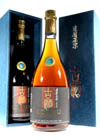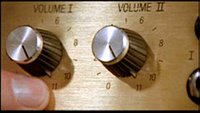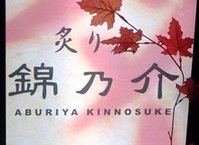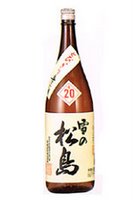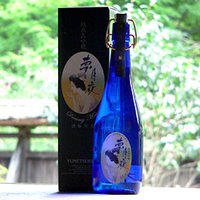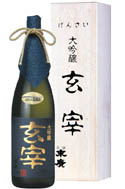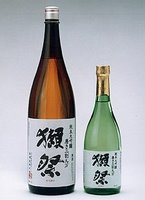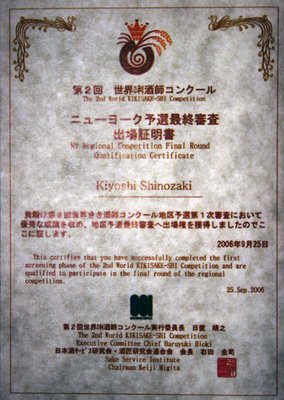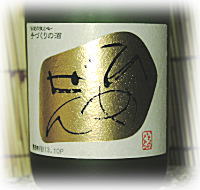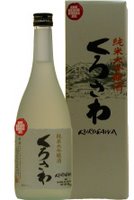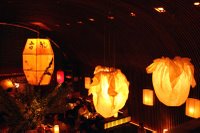 I truly believe that saké tasting experience is greatly enhanced when you have good people around you. Now when that circle of people includes saké brewers, well, the event becomes momentous.
I truly believe that saké tasting experience is greatly enhanced when you have good people around you. Now when that circle of people includes saké brewers, well, the event becomes momentous.I had a chance to be up and close with Mr. Kosuke Kuji from Nanbu Bijin Brewery when Toshi from Saké Hana asked me to help translate for the event.
 The event was attended by a lot of familiar faces, including Sakurai-san of Asahi Shuzo, Tim Sullivan of you know where, Lefty from NY Saké Meetup Group, Toshi-san's better half Tomo-chan and her partner in crime Chie-san (left, in the picture), my co-worker Akiko & her husband Drew (right and center in the picture), and tasting event regular Ai-san. No, there was no pressure what-so-evah!
The event was attended by a lot of familiar faces, including Sakurai-san of Asahi Shuzo, Tim Sullivan of you know where, Lefty from NY Saké Meetup Group, Toshi-san's better half Tomo-chan and her partner in crime Chie-san (left, in the picture), my co-worker Akiko & her husband Drew (right and center in the picture), and tasting event regular Ai-san. No, there was no pressure what-so-evah! First, a little background about Nanbu Bijin Brewery: Based in beautiful Iwate Prefecture surrounded in nature, the company was established in 1902 as a retailer before beginning production in 1915. Mr. Kuji is the fifth generation running the brewery. Their philosophy is to brew saké by taking advantage of natural resources of Iwate. Their ideal saké experience is to bring a smile to people's faces without having them think about it.
First, a little background about Nanbu Bijin Brewery: Based in beautiful Iwate Prefecture surrounded in nature, the company was established in 1902 as a retailer before beginning production in 1915. Mr. Kuji is the fifth generation running the brewery. Their philosophy is to brew saké by taking advantage of natural resources of Iwate. Their ideal saké experience is to bring a smile to people's faces without having them think about it.This concept of enjoyment was very evident from Mr. Kuji's contagious smile. Although he didn't speak much English, he had a gift of communicating with the audience through sheer force of his charisma. There were smiles and laughter echoing througout the evening.
So, what did the sakés taste like?
 We started with their entry level Tokubetsu Junmai (SMV: +7, Acidity: 1.5, Rice: Gin-otome, Seimaibuai: 55%, Yeast: Assoc #9). Using the local rice, this is a very straight forward with flavors of steamed rice, mild fruits, and touch of cinnamon leading to a finish with balanced sweetness and bitterness. The very dry finish and depth makes it food-friendly, and I'd imagine it would be a good candidate to serve warm as well.
We started with their entry level Tokubetsu Junmai (SMV: +7, Acidity: 1.5, Rice: Gin-otome, Seimaibuai: 55%, Yeast: Assoc #9). Using the local rice, this is a very straight forward with flavors of steamed rice, mild fruits, and touch of cinnamon leading to a finish with balanced sweetness and bitterness. The very dry finish and depth makes it food-friendly, and I'd imagine it would be a good candidate to serve warm as well. After the little warm-up, Kuji-san wasted little time in getting to the good stuff in the form of Junmai Daiginjo (SMV: +5, Acidity: 1.3, Rice: Yamadanishiki, Seimaibuai: 35%, Yeast: Iwate #2). Aged for one year prior to releasing, it shows good expression of melon, lychee, and mild amami with a mildly dry finish. Incidentally, this was one of the sakés selected for Japan Airlines in-flight saké list for next year. For those interested, their current list can be seen here.
After the little warm-up, Kuji-san wasted little time in getting to the good stuff in the form of Junmai Daiginjo (SMV: +5, Acidity: 1.3, Rice: Yamadanishiki, Seimaibuai: 35%, Yeast: Iwate #2). Aged for one year prior to releasing, it shows good expression of melon, lychee, and mild amami with a mildly dry finish. Incidentally, this was one of the sakés selected for Japan Airlines in-flight saké list for next year. For those interested, their current list can be seen here. The next on deck was a special and rare selection, a Shizuku (free-run, or trickle) style Daiginjo made for competition purposes. While using traditional pressing method like accordion- shaped Yabuta machine or tub-like Fune yield healthy amount, Shizuku relies solely on gravity with limited run time of four hours to avoid oxidization. The result is a yield that would be 1/40th of the usual pressing. Apparently, this saké was tremendous, but I wouldn't know because I was too busy explaining and didn't get to try it (they had already ran out when I asked for a glass later.)
The next on deck was a special and rare selection, a Shizuku (free-run, or trickle) style Daiginjo made for competition purposes. While using traditional pressing method like accordion- shaped Yabuta machine or tub-like Fune yield healthy amount, Shizuku relies solely on gravity with limited run time of four hours to avoid oxidization. The result is a yield that would be 1/40th of the usual pressing. Apparently, this saké was tremendous, but I wouldn't know because I was too busy explaining and didn't get to try it (they had already ran out when I asked for a glass later.) The next special saké eased my pain somewhat, as Kuji-san introduced a 10 Year Old Daiginjo (SMV: +4, Acidity: 1.2, Rice: N/A, Seimaibuai: N/A, Yeast: N/A), which is not available for purchase anywhere. Kuji-san explained that this came straight from the brewery's storage, reserved for guests of honor at the kura. It's so rare, that even he had yet to taste it! Upon tasting, he noted that this is a great demonstration of the changing style of saké production, proclaiming this as a prototypical "traditional" style as opposed to modern, fruitier style. The "traditional" style seems much closer to the Ginjos, with its very clean approach. The flavor was mildly fruity with notes of green apples. Despite aging for 10 years, the cold fermentation and lack of inpurities kept the saké clear; where the effect of aging was evident was in the very round and mellow flavor profile and overall mild profile.
The next special saké eased my pain somewhat, as Kuji-san introduced a 10 Year Old Daiginjo (SMV: +4, Acidity: 1.2, Rice: N/A, Seimaibuai: N/A, Yeast: N/A), which is not available for purchase anywhere. Kuji-san explained that this came straight from the brewery's storage, reserved for guests of honor at the kura. It's so rare, that even he had yet to taste it! Upon tasting, he noted that this is a great demonstration of the changing style of saké production, proclaiming this as a prototypical "traditional" style as opposed to modern, fruitier style. The "traditional" style seems much closer to the Ginjos, with its very clean approach. The flavor was mildly fruity with notes of green apples. Despite aging for 10 years, the cold fermentation and lack of inpurities kept the saké clear; where the effect of aging was evident was in the very round and mellow flavor profile and overall mild profile. The last saké of the night was another rarity, as Mr. Kuji introduced All Koji 2006 (SMV: -20, Acidity: 3.5, Rice: Toyonishiki, Seimaibuai: 65%, Yeast: Assoc #1601 and Assoc #77) served in a Champagne glass with a fresh strawberry inside. As the name indicates, this is made 100% using Koji yeast starter, while regular saké would contain 20% Koji. Although this was a style developed by Nanbu Bijin, but because the media wrote about this saké prior to release, they were unable to obtain a patent due to a loophole Japanese patent law. After tasting it with a strawberry inside, I asked to try it on itself to find out that it had a gentle nose of steamed rice, with a rich body with a long sweet/bitter finish.
The last saké of the night was another rarity, as Mr. Kuji introduced All Koji 2006 (SMV: -20, Acidity: 3.5, Rice: Toyonishiki, Seimaibuai: 65%, Yeast: Assoc #1601 and Assoc #77) served in a Champagne glass with a fresh strawberry inside. As the name indicates, this is made 100% using Koji yeast starter, while regular saké would contain 20% Koji. Although this was a style developed by Nanbu Bijin, but because the media wrote about this saké prior to release, they were unable to obtain a patent due to a loophole Japanese patent law. After tasting it with a strawberry inside, I asked to try it on itself to find out that it had a gentle nose of steamed rice, with a rich body with a long sweet/bitter finish.Although the tasting officially ended at this point, we had an obligation to finish what Mr. Kuji brought, as afterall, it would be cruel for him to carry all those bottles home. It took a couple more hours, but we did polish off everything.
 The night got even more special, when one of my friend says, "hey, isn't that the baseball player?" I turned around to look, thinking it was the saké talking. Well, what do you know, there's Hideki Matsui from the Yankees sitting by the window. We left him alone until we had to leave, but he was very gracious in posing for a picture, as I happened to have a camera ready because of this event! (Flanked by Tomo-chan, Ai-san, and me).
The night got even more special, when one of my friend says, "hey, isn't that the baseball player?" I turned around to look, thinking it was the saké talking. Well, what do you know, there's Hideki Matsui from the Yankees sitting by the window. We left him alone until we had to leave, but he was very gracious in posing for a picture, as I happened to have a camera ready because of this event! (Flanked by Tomo-chan, Ai-san, and me).




